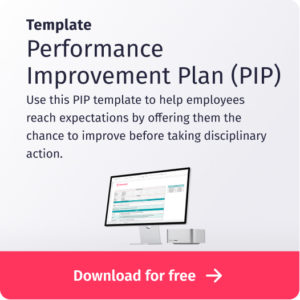How can managers encourage struggling employees to do better? This question has become even more important as employers are looking for ways to review the performance of remote employees. A performance improvement plan (PIP) will give workers a roadmap to increased success.
But performance improvement plans are still controversial. They have a bad reputation amongst employees, who see them as one step from a firing. In fact, research shows that some employees see performance reviews as inaccurate and aren’t motivated to work harder.
This means that managers using PIPs should take steps to communicate with employees in a way that resonates. Here, we’ll explore the most effective ways to create and implement a performance improvement plan —without burning bridges with employees.
TABLE OF CONTENTS
What Is a Performance Improvement Plan?
When Should a Performance Improvement Plan be Implemented?
Benefits of Performance Improvement Plan
How to Address Attitude in a Performance Improvement Plan
How to Write a Performance Improvement Plan
Performance Improvement Plan Best Practices
Employee Attendance Improvement Plan Example
How to Respond to a Performance Improvement Plan: A Guide for Employees
Is a Performance Improvement Plan Bad?
Performance management software 🚀
What Is a Performance Improvement Plan?
A performance improvement plan is a formal document to help employees reach expectations they may be struggling to meet.
Such a plan will offer honest performance appraisal, giving employees insight into performance gaps and areas where they are falling short. After that, it will provide precise steps for how they can do better. A PIP will create a specific timeline with intermediary goals to guide employees and improve performance.
It will also include clear consequences for employees who do not meet expectations. These might range from disciplinary action to termination of employment. Employees presented with PIPs must reckon with their shortcomings in order to become the workers the company needs.
When Should a Performance Improvement Plan be Implemented?
Employers can tailor a performance improvement plan template to fit any problem. For example, a PIP may focus on improving work quality, goal setting, or meeting growth numbers. Correctly implemented, an employee improvement plan may work wonders for struggling employees. It will give employees exact instructions on how to improve and a clear metric for measuring their improvement.
In order to be effective, PIPs must be motivated by a sincere desire to help employees to improve. Because of their reputation, PIPs may make employees nervous. This means managers issuing PPIs should be prepared to communicate clearly about their expectations, check in regularly, and support employees. All of this will help boost employee morale.
That said, PIPs aren’t only for employees who are struggling in their roles. They can also help structure a position for an employee who feels unfulfilled. A PIP can prepare an employee to transition into a higher-level role or move laterally into a role that is a better fit.
Benefits of Performance Improvement Plan
PIPs enable employee mobility and personal growth. Therefore, they can benefit both employee and employer. The performance appraisal benefits are endless.
Culture of Accountability
When employers invest in bettering their employees rather than letting them go for slip-ups or poor performance, employees feel more engaged with the company. Using a performance review form empowers employees to make necessary changes and for managers to create a high-performance culture.
Save Time and Money
By addressing and fixing issues thanks to your performance improvement plan and other performance management tools, employers can boost productivity in the workplace and keep their staff on track. PIPs may be more effective than an annual performance appraisal because they are taken very seriously by employees.
Additionally, PIPs give employees a second chance, which reduces turnover. This will not only save employers the costs associated with letting workers go and training new hires. It will also save them the costs of low morale associated with firings.
Reduce Liability
PIPs provide a formal document stating an employer’s dissatisfaction with an employee’s performance. This makes it more difficult for an employee to win a case claiming unjust or unlawful termination down the road. While this does protect employers, it is also the reason employees are uncomfortable when they receive a PIP.
How to Address Attitude in a Performance Improvement Plan
Talking to an employee about performance improvement is never easy, especially when it is tied to overall attitude. It might lead to a situation where employees become defensive feel that they are being asked to meet impossible goals. They may fear that their jobs are at risk. Although good managers will always find a way to be kind and respectful, the conversation may still be uncomfortable and upsetting.
Here are our tips to make sure the interaction leaves the employee feeling supported instead of abandoned.
Be Specific
An employee appraisal needs to draw on real-life examples. Instead of telling an employee that their work quality is low, employers should prepare to point to specific instances. Perhaps the employee is not taking certain responsibilities seriously. Perhaps they consistently miss important deadlines and don’t seem to be making any effort to improve. Whatever the problem, employers may be able to use performance management software to identify a pattern and not just a single occasion.
Has the employee already been asked to fix this problem? Employers may not need PIPs if they communicate openly with their staff about performance ongoing. If the employee has been warned, employers should be sure to point this out.
Focus on performance
PIPs are opportunities for growth and improvement. Managers holding these difficult conversations must stay focused on performance goals. Personal attacks in this scenario, as ever, are out of line. Proactive managers can keep a record of performance evaluations with a 360 review template or a 9-box grid and use these examples to see how others organize these discussions.
How to Write a Performance Improvement Plan
One of the most important aspects of a PIP is the performance evaluation form. This is the written document employers will make with employees to record objectives and a timeline for improvement. Here are some key considerations for employers developing an employee evaluation form.
Define acceptable performance
How would a high-performing employee be completing this role? Instead of focusing on what they don’t want, employers should first have a firm understanding of what they do want. Then, they can work backward to determine where the employee is falling short and where they can improve.
Create measurable objectives
Give the employee insight into the business’s performance appraisal system. What do they need to do to improve? Use the SMART framework (Smart, Measurable, Attainable, Relevant, Time-based) to create goals employees can reasonably achieve. Keep track of employee performance metrics and take feedback into account. If they say expectations are unreasonable, there may be a good reason for it.
Outline resources and support
What resources will be available for employees who need to develop new skill sets? Managers can offer support through training, and performance coaching. Similarly, they can encourage employees to ask their peers for guidance. Consider how to address the root of the problem.
Schedule check-ins
One of the most important parts of the performance appraisal form is scheduling regular meetings between the manager and employee. The manager should use these meetings as an opportunity to practice continuous performance management and ensure that the employee is meeting incremental goals and developing according to the PIP. Employees will be able to voice any doubts or difficulties.
State the consequences
There’s no way around it. Although PIPs should ideally help an employee to reach their potential, the possibility exists that they might not. An employee performance improvement plan form should include the repercussions of not meeting expectations.
With these considerations in mind, a manager will be able to draw up a clear and reasonable PIP.
Performance Improvement Plan Best Practices
While PIPs can help struggling employees improve performance, the PIP process can also cause stress. What are the best employee performance management practices to make sure the PIP goes over as smoothly as possible?
Make a plan
First, create a plan. Organize a meeting with both the employee’s manager and hr present. Meanwhile, prepare what to say ahead of time, and make sure to have an employee evaluation form ready.
Listen to your employee
Give the employee an opportunity to respond with any thoughts or comments. The employee is sure to have valuable feedback about the demands of their position or extenuating circumstances. Some businesses may offer a self-appraisal form to see how employees perceive their own recent performance.
Find the root cause of the issue
If an employee is showing poor performance, chances are there is a good reason. This employee was hired because of their skills and their attitude, so they are probably not faltering out of spite. Does the employee struggle to understand the expectations of their role? Are they having trouble outside of work that is affecting their performance? Investigate specific issues through targeted performance review questions and offer support accordingly.
Emphasize the positive
Emphasize the employee’s positive attributes and the impact they have made on the business. This is an opportunity for them to create a personal improvement plan. Help them to find ways to expand their positive influence.
Provide Guidance
The supervisor evaluation will help employees to better understand the business’s expectations. Clear goal-setting will give employees a clear path to follow and help them to reach objectives.
Check-in regularly
Track the employee’s progress after the initial meetings. Is their improvement in line with any interim goals? Regularly touching base will help to keep employees motivated and moving in the right direction. Offer an employee review form so employees can evaluate their own progress.
Employee Attendance Improvement Plan Example
A PIP might be used to resolve a number of situations. Here, we’ll explore how to use a staff performance evaluation to address an employee’s spotty attendance record.
The first step is to explain what kind of attendance is expected of the employee. Show the employee how their behavior is affecting the rest of the staff. Are the employee’s colleagues having to cover shifts on short notice or pick up the slack? Demonstrate a history of absences using absence-tracking software.
Secondly, create measurable objectives. In this instance, it might be no absences or late arrivals in the next month.
Thirdly, figure out if there is any way you can support the employee. Do they need a different shift so that they can be free to pick up their kids from school in the afternoon? Schedule check-ins to meet throughout the month and discuss the employee’s progress.
Finally, let the employee know the consequences they will face if they continue missing work. In end, the PIP form should include some version of the following:
Goal: To reduce absenteeism
Objectives: Arrive on time, no absences for a month
Action: Only miss work when authorized for medical or personal reasons
Support: Shift switches if necessary
Check-ins: Every Friday at 10 am for the next month
How to Respond to a Performance Improvement Plan: A Guide for Employees
For employees being called in to discuss a PIP with their manager, the process can be nerve-wracking. Maybe the manager pointed out room for improvement before, but the employee didn’t realize it was quite so serious. The good news? This employee evaluation is an opportunity for employees to step up their game and improve their performance. How they react will either win the trust of their bosses for the long term or further reduce confidence.
Be honest with yourself
It can sting when the boss says your work isn’t up to par, but it is also a valuable opportunity for reflection. Think carefully about your performance. Have you been preoccupied with other things recently? Have you been letting things slide?
If your boss asks you to self-evaluate, consider checking out how to write performance reviews for yourself examples so you can present a more objective picture.
Make your job a priority
It’s time to refocus on work. Make sure you have enough time to give your projects the attention they deserve. Show your manager what makes you shine.
Seek help when you need it
Self-improvement is never easy. Fortunately, a performance improvement plan probably means that your company is interested in helping you grow in the right direction. If you feel that you have received an unfair performance improvement plan, be sure to communicate clearly with your boss about how it could be adjusted. Don’t squabble about past incidents. Instead, focus on the future and meet the objectives before you. Make sure to take advantage of the resources available to you.
Stay positive
Although your ego may have taken a hit, it’s more important than ever to keep a positive attitude. Show your manager that you are willing and eager to make the necessary adjustments. To sum up, don’t let small challenges hold you back!
Is a Performance Improvement Plan Bad?
Is a PIP a bad thing? It certainly doesn’t have to be. Employers should never use a PIP as a superficial step before termination. Like salary reviews, pay for performance models, and stack ranking, performance improvement plans have consequences.
However, PIPs do offer a legitimate opportunity for growth. If managers conduct a PIP with the intention of listening to their employees’ perspectives, performance improvement plans can be constructive. If employees are open to change, both may be able to work out a plan and learn from the discussion.
By seeking employee evaluation examples, employers will be able to craft the best performance improvement plan possible to get a valued employee on the right track.
Manage Your Performance Reviews with Factorial. With Factorial you can manage so much more than your team’s performance. Factorial’s software for small business management centralizes all core business functions. Try it today with a free 14-day trial.






Very educative